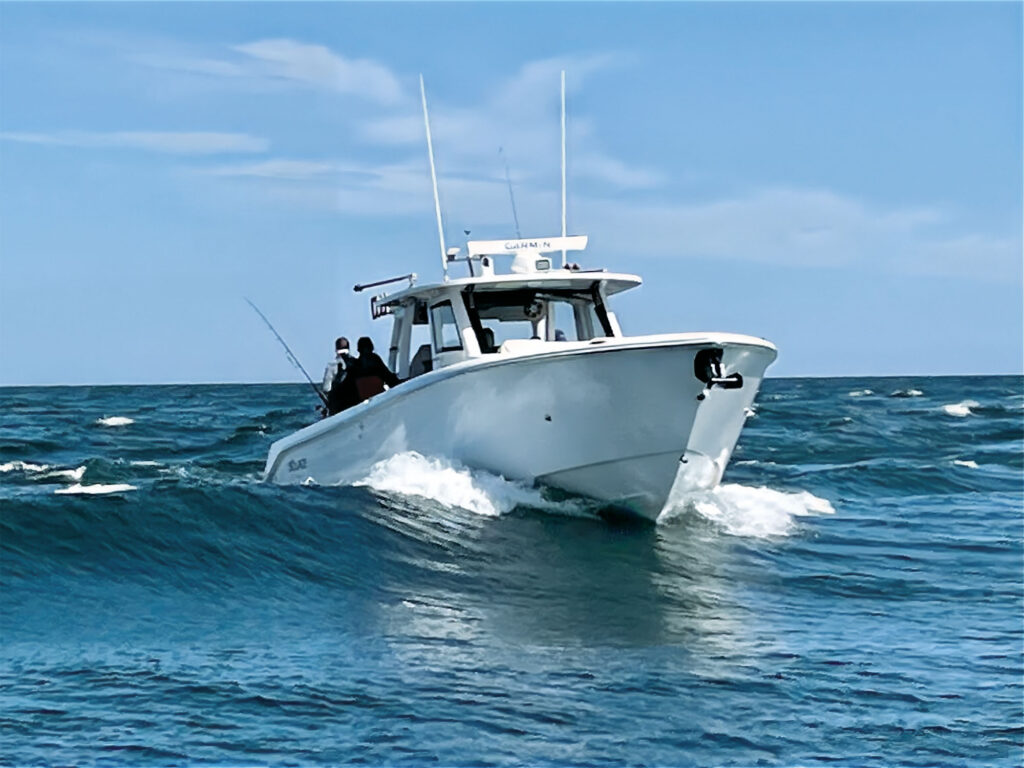Understanding the Basics of Boat Trim
 Using boat trim properly can produce a smoother ride.
Kevin Falvey
Using boat trim properly can produce a smoother ride.
Kevin Falvey
Bowrise, or inclination, affects several aspects of your boat’s ride and handling. The basic thing to remember is that if the bow is up, the stern is down—and vice versa.
So, if you are navigating a shallow bit of water, it’s important to keep the bow down. As stated, keeping the bow down keeps the stern up. In this situation, we see many boaters with outboards and sterndrives who, properly, trim the drive up to reduce draft. However, just as many times we see the same boaters, and operators of inboard-powered craft as well, using too much power to go slow. Do so, and the trimmed drive—and built-in shaft angle of an inboard—depresses the stern, the bow rises, and the prop kicks up mud, sand, shells, or worse. Plus, operating like this causes the cooling water intakes to ingest more silt and sand.
Practice going slow at minimal rpm. It takes practice because operating at 600 or 800 rpm (for gas engines) doesn’t inspire confidence. It requires more attention to the helm, oversteering and correcting. Of course, in some situations, wind or current will dictate the use of higher rpm. But most times, operating slow at the least rpm helps the bow stay down and the stern stay up.
A boat carrying its bow too high while attaining plane can limit visibility forward and make for a bumpy, splashy transition before the boat levels out. Adding weight forward is one way to get your bow down quicker. For smaller boats, this might be accomplished by stowing the portable fuel tank forward, or having your crew sit up front, or even by the use of an extension handle to get the weight of the skipper of a tiller-steered outboard more forward.
Larger boats so equipped can trim the engine all the way in and deploy the trim tabs to help attain plane. Changing to a lower-pitched propeller, or one with a larger diameter, can also help to get a boat planing sooner. Changing props will have other effects, though, so be aware of potential trade-offs, such as reduced rpm or top speed.
Read Next: How to Maintain a Boat’s Trim-and-Tilt System
Boats operating at planing speed can also suffer poor performance indicated by carrying their bow too high, or even too low. Ideally, and in general, a boat on plane will be most efficient at about 3 to 4 degrees of inclination. That number might be less for stepped hulls, the trim of which is built-in. So, once planing, retract the trim tabs and (if not inboard- or water-jet-powered) begin trimming out the drive. Do this without changing throttle position much. Do so and you’ll watch the bow lift and rpm increase as you trim out. Too much trim, and speed will begin to fall off and the boat could start to porpoise. Too little trim, and you will be running bow down, aka plowing, producing a wetter ride and burning more fuel because there is more of the hull in the water to create drag.
Now, on rough days, you might want to trade off some efficiency and a drier ride for the smoother ride that a bow-down attitude might bring. Using the information in this article hopefully makes you aware of your choices, and the trade-offs, of boat trim.
The post Understanding the Basics of Boat Trim appeared first on Boating Mag.
- Home
- About Us
- Write For Us / Submit Content
- Advertising And Affiliates
- Feeds And Syndication
- Contact Us
- Login
- Privacy
All Rights Reserved. Copyright , Central Coast Communications, Inc.